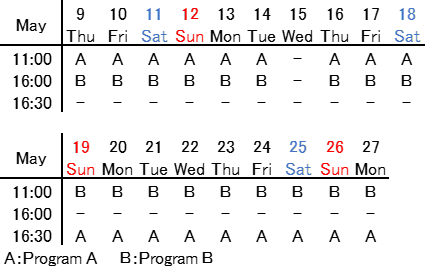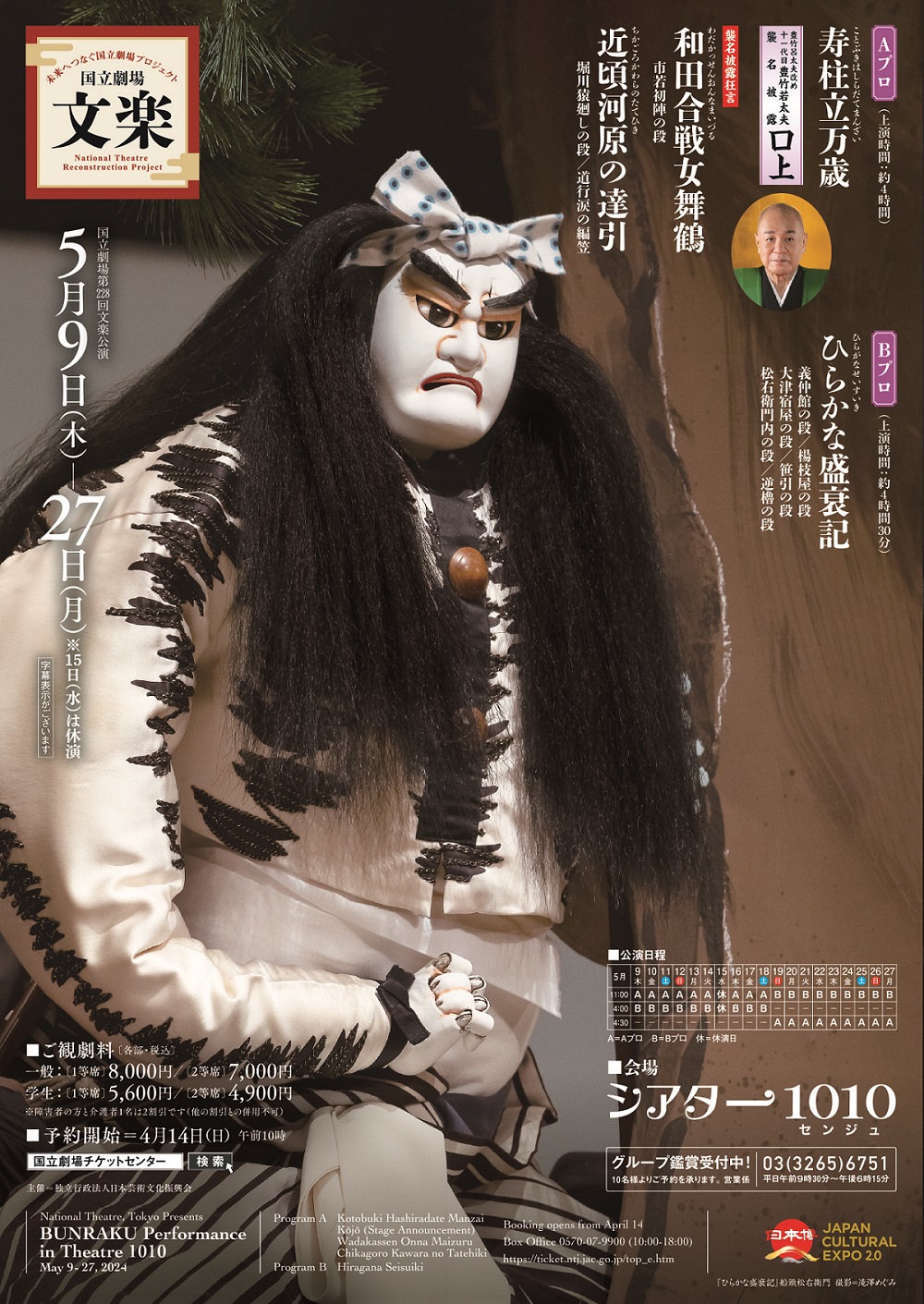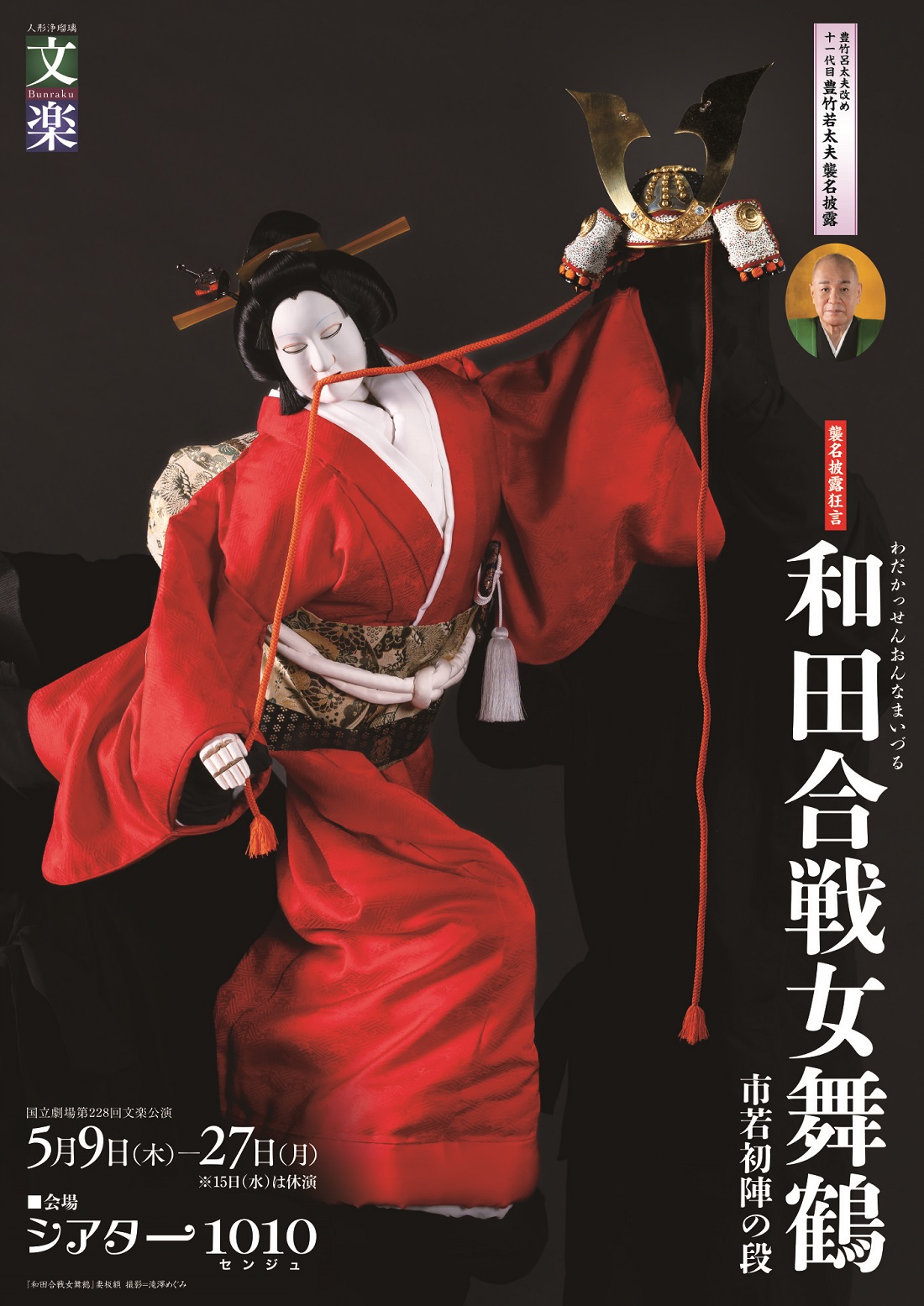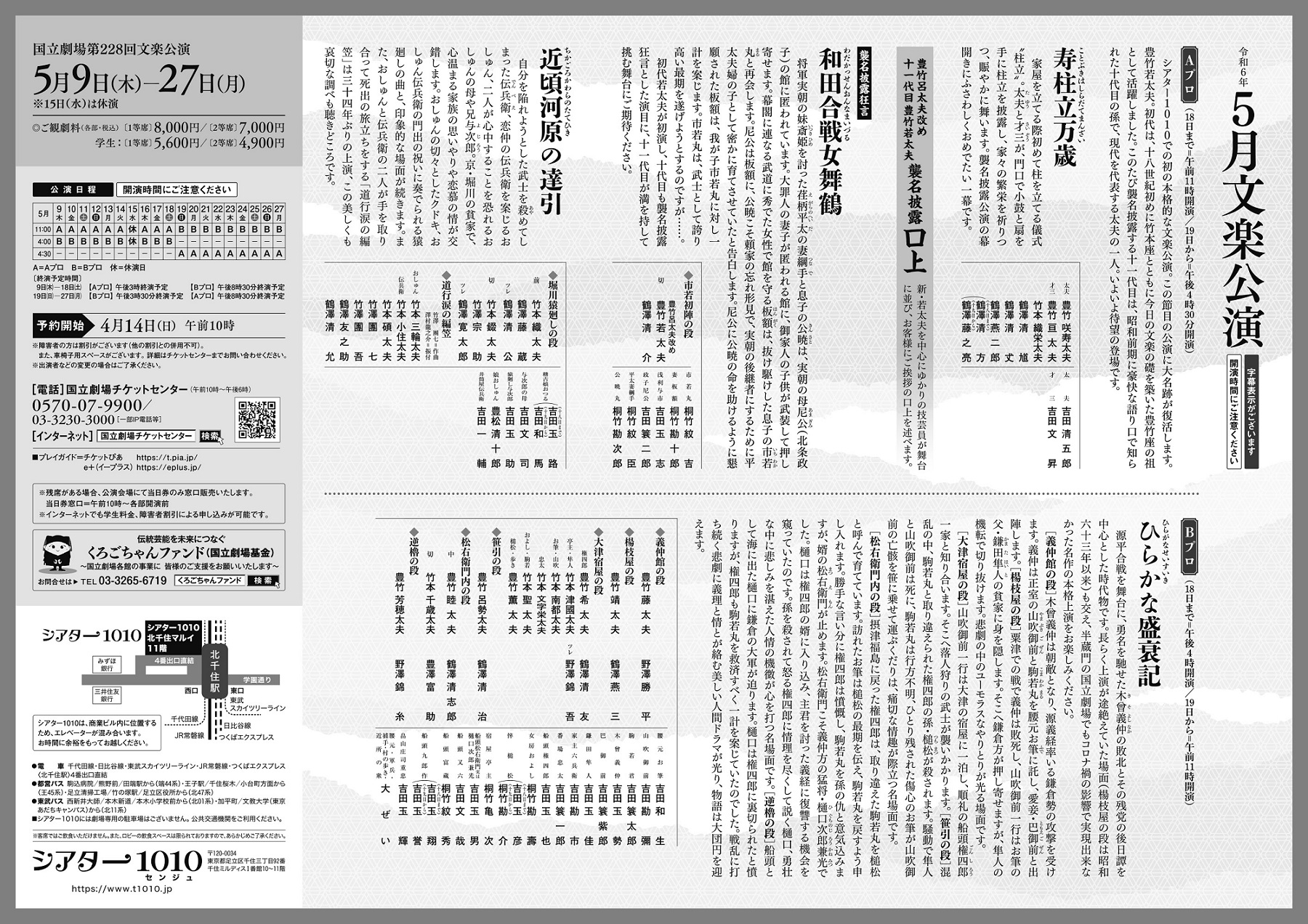- Bunraku
- Other Theater
Bunraku Performances
Bunraku Performances in May 2024 in Theatre 1010 (Adachi Ward Cultural Arts Theatre)
Performance Dates : May 9 (Thu.) - May 27 (Mon.), 2024
No performance on 15 (Wed.)
Venue : Theatre 1010 (Adachi Ward Cultural Arts Theatre)
Program A (Running Time : Approx. 4 hours)
Kotobuki Hashiradate Manzai
Kōjō (Stage Announcement)
Wadakassen Onna Maizuru
Chikagoro Kawara no Tatehiki
Program B (Running Time : Approx. 4 hours and 30 minutes)
Hiragana Seisuiki
Ticket Prices for Each Program(tax included)
Adults: 1st Grade ¥8,000 2nd Grade ¥7,000
Students: 1st Grade ¥5,600 2nd Grade ¥4,900
Seating plan
*Audio guide: English commentary through the Audio Guide service will be available. Click here for details of audio guide.
*Subtitles: Available only in Japanese. Displayed on screen beside the stage.
*English synopsis is available. It is included in the paid Japanese brochure.
*There will be intermission.

Program A Program B
Booking Opens
April 14 (Sun.), 10:00AM
* If there are still tickets available for purchase on the day of the event, you may purchase them in person at the Box Office for this performance.
Box Office (on-site) : Open from 10:00 AM until each curtain time.
*Tickets for students and persons with disabilities for this performance are available online.
-----------------------------------------------------------------------------
Box Office (by phone)
0570-07-9900 (From overseas: +81-3-3230-3000) in Japanese and English
(10:00AM - 6:00PM)
Online Booking : https://ticket.ntj.jac.go.jp/top_e.htm
-----------------------------------------------------------------------------
The National Theatre’s Bunraku Performance in May takes place at Theatre 1010, where Toyotake Wakatayū – one of the daimyōseki (significant stage names) in Bunraku – is revived for the first time in 57 years. Toyotake Wakatayū I flourished as the founder of Toyotake-za, which laid the foundation of today’s Bunraku, along with Takemoto-za in the early 18th century. This is the inaugural performance for the stage name succession of Toyotake Wakatayū XI – the grandson of Toyotake Wakatayū X, who was famous for his glorious style of narrating in the mid-20th century, who is one of the leading tayū (Bunraku reciters) today. We are pleased to present his much-awaited appearance on the stage!
Kotobuki Hashiradate Manzai
Hashiradate is a festive ritual that accompanies the building of the first pillar of a new house. Standing in the doorway with a kotsuzumi (small drum) and folding fan in hand, the manzai duo of Tayū and Saizō perform the hashiradate , gaily dancing and praying for the prosperity of the families in the home. This is an auspicious performance that is most appropriate for the opening performance for a stage name succession.
Stage Announcement by Toyotake Wakatayū XI
Newly named Toyotake Wakatayū, along with several Bunraku performers closely connected to him, will appear onstage and deliver commentary commemorating his name succession.
Performance in Commemoration of the Name Succession: Wadakassen Onna Maizuru
Tsunade and Kinsato – the wife and son of Egara no Heida, who killed Princess Itsuki, a sister of the shōgun Minamoto no Sanetomo, are sheltered in the mansion of Amagimi (Hōjō Masako), Sanetomo’s mother. One day, armed children of gokenin (a retainer serving the shōgun) rush to the mansion, where the wife and son of the great offender have been given refuge. Hangaku, a female warrior who is excellent in martial arts, defends the mansion and is reunited with her son Ichiwakamaru, who did not join the armed children. Amagimi confesses to Hangaku that Kinsato is the son of Sanetomo’s late older brother, Yoriie, and that Heida and his wife were asked to secretly raise Kinsato as their son to make him a successor of Sanetomo. Entreated by Amagimi to save the life of Kinsato, Hangaku devises a plan involving her son Ichiwakamaru. Ichiwakamaru, for his part, attempts to meet his proud death as a warrior. However…
This program marks a long-awaited performance for Toyotake Wakatayū XI, one also performed by his predecessors Wakatayū I and Wakatayū X – this is a premier piece and a special performance to commemorate his name succession. Please join us for this special event!
Chikagoro Kawara no Tatehiki
Denbē unintentionally kills a warrior who attempted to trap him. Oshun worries about Denbē, who is her lover. Oshun’s mother and brother, Yojirō, are afraid that the couple will commit a double suicide. The fabric of human relationships, such as the heartwarming compassion for family members and passion between lovers, is woven around this poor family in Horikawa, Kyoto. A series of impressive scenes includes Oshun’s ardent kudoki (oral recitation passage) as well as sarumawashi (monkey show) music rendered to celebrate the couple’s new life. The piece “Michiyuki Namida no Amigasa,” depicting Oshun and Denbē going on their last journey hand in hand, will be performed for the first time in 34 years. The beautiful and yet sad melody accompanying the scene will be a highlight to remember.
Hiragana Seisuiki
Set during the Genpei War, this jidaimono (a Kabuki or Jōruri play featuring historical plots and characters, often famous samurai battles) is based on the defeat of Kiso Yoshinaka, known for his bravery, along with a sequel about his surviving followers. Including a scene presented for the first time after a long hiatus – “Yōjiya no Dan” was last performed in 1988 – this is a full-scale performance of the masterpiece and we invite you to please enjoy it to the fullest!
[Yoshinaka-yakata no Dan] Kiso Yoshinaka, who rebelled against the imperial government, gets attacked by the Kamakura forces led by Minamoto no Yoshitsune. Leaving his legitimate wife Yamabuki Gozen and his son Komawakamaru in the hands of his koshimoto (chambermaid) Ofude, Yoshinaka goes into battle along with his beloved concubine, Tomoe Gozen.
[Yōjiya no Dan] After Yoshinaka dies in the battle in Awazu, Yamabuki Gozen and her party hide themselves in the humble abode of Ofude’s father, Kamata Haito. Kamakura warriors soon arrive, but Haito uses his wits to navigate this crisis. What stands out in this part of the tale is the humorous interaction between the characters during a tragic situation.
[Ōtsu Yadoya no Dan] While staying overnight at an inn in Ōtsu, Yamabuki Gozen and her party become acquainted with the boatman Gonshirō and his family. Suddenly, the warriors hunting after the defeated soldiers appear and attack them.
[Sasabiki no Dan] In the midst of the confusion, Gonshirō’s grandson Tsuchimatsu is killed, as he was mistaken for Komawakamaru. Haito and Yamabuki Gozen also are killed and Komawakamaru goes missing. Ofude now finds herself left alone. The passage in which heartbroken Ofude hauls the bamboo leaves and branches with Yamabuki Gozen’s body on it is a famous scene that is lent color by its poignant sentiments.
[Matsuemon Uchi no Dan] Having returned to Settsu Fukushima in Osaka, Gonshirō has been raising the child with the mistaken identity, Komawakamaru, calling him Tsuchimatsu. One day, Ofude comes along. After revealing the death of Tsuchimatsu, she asks Gonshirō to return Komawakamaru. Upset and outraged at her one-sided claim, Gonshirō shouts at her, saying, “this child is my enemy. I’ll kill him now to avenge my grandson’s death.” However, he is stopped by his son-in-law Matsuemon. Matsuemon is actually Higuchi no Jirō Kanemitsu, a brave general on Yoshinaka’s side. As Gonshirō’s son-in-law, he has long been waiting for his chance to settle an old score with Yoshitsune, who killed his master. Higuchi tries to persuade Gonshirō, who is furious about his grandson’s death, by appealing both to his heart and head. This is a memorable scene in which brave and yet sad human nature appeals to the heart of the audience.
[Sakaro no Dan] The great army of Kamakura closes in on Higuchi, who is now at sea as a boatman. He becomes angry, thinking he was betrayed by Gonshirō. The reality, however, is that Gonshirō was also working out a plan to save Komawakamaru. As this beautiful human drama unfolds through a series of tragedies that take place during the chaos of war, along with the characters’ sense of duty and love, this moving story comes to its conclusion.
in Japanese










